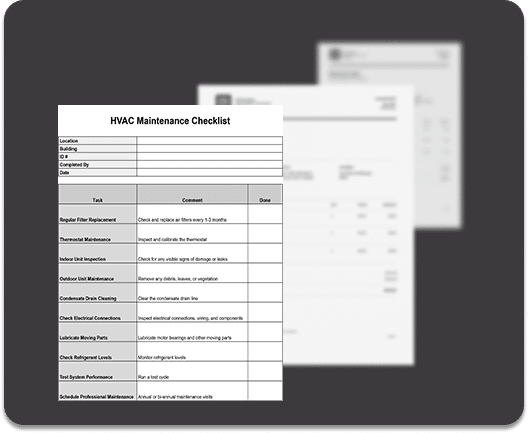Common Challenges in Field Services
Field service organizations face a variety of obstacles that impact their operational efficiency and effectiveness. Many of these issues have been exacerbated by the COVID-19 pandemic, which has significantly influenced customer needs and expectations, labor hiring costs, and the overall size of the workforce.
Companies operating in the field service sector must now contend with these common challenges:
- Technician scheduling and dispatching – Organizations that still rely on traditional, manual tools (like spreadsheets) for their scheduling and dispatching processes often struggle to keep up with ever-changing appointments and proper job matching. Field workers have varying skill sets, roles, certifications, and responsibilities, so matching them to the right job—and getting them there on time and fully prepared—can be an operational nightmare for already busy staff schedulers. These processes are even more time-consuming and frustrating if schedulers don’t have access to the real-time locations of their field workers or the progress of their work. The result is inefficient, ad-hoc scheduling and dispatching that fails to meet both customer and employee needs.
- Service delivery optimization – In an effort to offset their own costs, some field service companies have had no choice but to drive up the price of delivering their services. They simply don’t have the right processes and tools in place to streamline their operations, reduce their labor costs, or maintain worker productivity. A lack of transparency into their daily operations often hinders their ability to optimize service delivery, ensure customer satisfaction, and sustain profitability.
- Keeping up with digital transformation – Despite their efforts to transform, many field service businesses still lack the digital maturity to keep up with their competitors. They take a siloed approach to adopting new technologies, face slow implementation timelines, invest in tools that go unused, and run into tool sprawl issues. Digitally mature companies are 26% more profitable than their peers, but the pressure to keep up can cause some field service organizations to execute half-baked, unsuccessful transformation strategies.
- Reliable, punctual customer service – Today, customer experience and brand perception are absolutely crucial to a company’s success. Customers have myriad options and instant access to customer reviews, so they have come to expect superior service every step of the way. Unstable scheduling and dispatching processes, communication issues, and a lack of workforce visibility all result in operational inefficiencies that threaten a field service company’s ability to provide reliable customer service. And since 62% of customers say they share their negative experiences with others, ignoring issues in customer service can mean leaving potential revenue on the table.
- Recruitment and retention – Field service organizations often face chronic employee turnover due to inflexible schedules, a poor workplace culture, insufficient tools, and workflow frustrations. In fact, 36% of deskless workers say they want to leave their current jobs. But replacing field workers is time-consuming and costly, especially since many of them have unique skill sets, certifications, and experience that are difficult to find. Constant new-hire recruiting, onboarding, and training all lead to lost productivity and errors, which damage a business’s operational health.
What Does Successful Field Service Operations Look Like?
Overcoming the challenges associated with field services requires implementing the proper processes and tools that keep your operations running like a well-oiled machine. A successful field service operation has strong practices for scheduling and dispatching, communication, routing, and workforce analytics to ensure an exceptional customer experience every time.
An internet service provider, for example, maintains their competitive advantage by prioritizing the needs of their field service workers and their customers. They leverage an intelligent scheduling and dispatching process—backed by powerful, mobile-first tools—to support the delivery of their installation and maintenance services.
Using the mobile platform, a customer can schedule an appointment to have a fiber-optic internet connection installed at their residence. The service provider instantly receives and accepts the appointment request through their field service app. The tool automatically matches and assigns the job to the right technician, based on their real-time location, skill set, certifications, preferences, and more. Then, the app provides the most optimized route to get the field worker to the job as quickly and safely as possible.
Once the technician arrives at the customer’s location, they’re fully prepared to perform the installation. They can check the same field service app for customer details, relevant manuals, and other key resources. If they have additional questions, they can easily use the app to connect and communicate with colleagues who are either in the field or back in the office.
As they install the equipment, the technician can capture job notes, customer signatures, and track their progress within the app. Back-office supervisors and schedulers are always up-to-date on where their field workers are and how far along they are on any given job.
From the customer’s perspective, the installation process is easy and seamless. They can book the installation (and any follow-up maintenance) at a time that works best for them. They know exactly when the technician will arrive, as the app updates them with key appointment details in real time. They’re met with a confident, well-prepared technician who has everything they need to deliver an excellent experience.
Once the job is complete, the resulting data doesn’t go to waste. The internet service provider’s field service tool is connected to the company’s other existing systems, which makes it easy for them to generate meaningful, actionable reports. Using this data, they can uncover inefficiencies, make informed decisions around customer service, reveal opportunities for improvement, and make strategic moves in real time. They continuously boost their field service operations by analyzing team performance and measuring their customer experience.
But this high level of operational efficiency doesn’t occur by accident. From resource deployment and scheduling to the completion of a job, competitive, forward-thinking field service organizations know they need several essentials to bolster their operational success:
- Processes and tools that help them manage full-time, part-time, and contracted employees
- Complete visibility into customer data
- An intelligent scheduling tool that can handle dynamic, complex schedules
- Automated job matching based on technicians’ experience, locations, qualifications, and more
- A user-friendly mobile app that doesn’t require in-depth training
- Optimized travel routes
- Seamless communication between field and back-office workers (and customers, too)
- Tools that track job progress in real time
- Mobile data collection capabilities
- Actionable field service reports
- Fully integrated technologies that connect data and can scale with the company


















